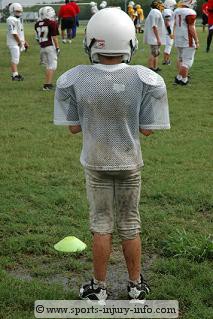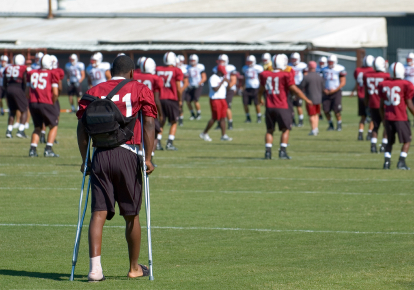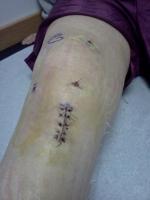Knee Injury Info
Knee injury is common with sports participation and daily activities. Injury to the knee can result in significant limitations in function, and long-term problems with osteoarthritis. Thousands of knee injuries occur each year, and appropriate evaluation and diagnosis is essential in order to ensure a full recovery and proper rehabilitation.
Some knee injuries require surgical intervention while others can be managed conservatively with initial treatment and rehabilitation. Determining the need for surgery is based on the type of injury you have, as well as the severity.
Below you will find more information on common knee injuries, as well as general information on the function of the knee joint.
Knee Joint Function
The knee is primarily a hinge type joint, made up of the articulation of the femur and tibia. It has four primary ligaments that provide stability (ACL, PCL, LCL, MCL), and two small pieces of fibrocartilage that provide shock absorption and increased joint congruency. All of these structures can, and are, injured with activities. Some injuries require surgical intervention to restore normal function while others can be managed with conservative treatment and rehabilitation.
The knee joint is a major weight bearing joint and plays a significant role in lower extremity function. It is a relatively stable joint when uninjured. Injuries to the cruciate ligaments can lead to abnormal wear and tear of the cartilage and articular surfaces. Injury to the meniscus can cause mechanical symptoms such as clicking, catching, and locking.
Regardless of what type of injury you have, proper evaluation and diagnosis by a healthcare professional is essential in the management of your injury. Below you will find more information on the most common knee injuries that occur with sports and recreational activities.
Common Knee Injuries
- Knee Pain
Generalized knee pain is often the first sign of knee injury. Knee pain can be caused by many different factors, and understanding the signs and symptoms of knee pain can help in the management of your injury. Learn more about common knee pain locations, and what type of injuries are associated with different types of knee pain. - Patellar
Tendonitis
This condition is a chronic problem with inflammation of the patellar tendon. It is often caused by running and jumping, and can significantly affect your ability to participate in sports and recreational activities. Severe cases can limit your daily activities. Learn more about patellar tendonopathy, common signs and symptoms, and general treatment guidelines. - Patella
Femoral Syndrome
Often used as a "catch all" diagnosis, patella femoral syndrome (PFS) is an irritation or pain around the knee cap. PFS is a common and complicated problem, with many potential underlying factors. Learn more about common signs and symptoms, treatment and rehabilitation options, and recovery timelines. - Patella
Chondromalacia
This condition is usually a result of patella femoral syndrome. It is softening or damage to the cartilage on the under surface of the knee cap, and is associated with early onset osteoarthritis. Patella chondromalacia often has significant pain levels, and can affect daily activities. Learn more about this condition, common signs and symptoms, and conservative and surgical treatments and rehabilitation. - Dislocated
Patella
Patellar dislocations are a serious sports injury that needs to be treated correctly for the best recovery. Learn more about common mechanisms of injury, acute treatment guidelines, surgical intervention, and rehabilitation
- The Unhappy Triad
This knee injury is actually injury to three separate structures at once. Most common with sports activities like soccer and football, injury to the ACL, MCL, and Meniscus comprise the unhappy triad. Learn more about mechanisms of injury, common signs and symptoms, treatment and rehabilitation guidelines, and surgical interventions.
- Torn
ACL
More than 100,000 athletes suffer ACL tears each year. This knee injury is an epidemic among athletes, especially females. Learn more about the common mechanisms for injury, signs and symptoms, surgical intervention, initial treatment, and rehabilitation.
- Torn
Meniscus
Meniscus tears are often considered "minor" knee injuries because they can be treated surgically with a relatively short recovery time frame. However, meniscus tears can lead to long-term problems like early onset osteoarthritis. Learn more about signs and symptoms, initial management, surgical intervention and rehabilitation. - Medial
Meniscus Tear
Detailed information on tears of the medial meniscus, including signs and symptoms, surgical management, and rehabilitation guidelines.
- Medial
Collateral Ligament Tear
One of the few knee ligament injuries that does not require surgical intervention, an MCL sprain is often treated successfully with conservative treatment and rehabilitation. Learn more about common injury mechanisms, treatment and rehab guidelines, and recovery timelines.
- PCL Knee Injury
Not as common as ACL knee injuries, the PCL can be injured with sports activities, and leads to instability, pain, and dysfunction. This injury can often heal well with conservative treatment, but does occasionally require surgical intervention. Learn more about the signs and symptoms, rehabilitation, and recovery. - Hamstring
Injury
An acute injury with a high recurrence rate, hamstring strains are often managed poorly. Learn more about the common causes of hamstring injury, rehabilitation and treatment guidelines, and recovery timelines. - Quadriceps
Strain
This injury involves any of the four muscles in the front of your thigh. Common with sports like football, soccer, and basketball, it can generally be managed conservatively. Learn more about the sign and symptoms, treatment and rehabilitation guidelines, and recovery time frames.
SII › Knee Injury


